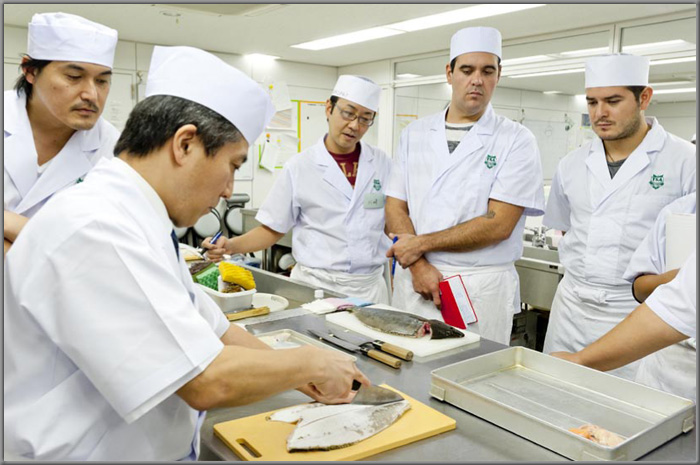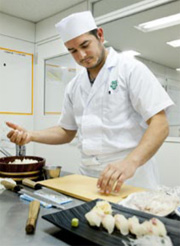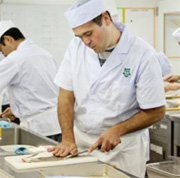Home > Highlighting JAPAN > Highlighting Japan APRIL 2012 > Food, Glorious Japanese Food
Highlighting JAPAN
COVER STORY: Food, Glorious Japanese Food

Caption: Francisco Herv叩s (right) and Benjamin Tuhakaraina (second from right) watch how Master Chef Ken Kawasumi fillets a flounder (hirame).
Credit: MASATOSHI SAKAMOTO
Food, Glorious Japanese Food
Not only is it delicious, Japanese food is beautiful and healthy too. Japanese dishes and ingredients are becoming increasingly popular around the world as a result. The seemingly endless variety on offer, from traditional dishes to modern alternatives, continues to delight visitors coming to Japan and is increasingly being exported too, tantalizing taste buds all over the world. In January this year, the Japanese government organized Japan Night 2012, an event aimed at showcasing Japanese food to participants at the World Economic Forum in Davos, Switzerland. It is also committed to promoting Japanese dishes and ingredients via overseas diplomatic facilities and various food-related events around the world. This month's Cover Story takes a look at what people around the world love so much about Japanese food.

Francisco Herv叩s makes hirame sushi
Credit: MASATOSHI SAKAMOTO
Students at the Tokyo Sushi Academy in Shinjuku are learning how to fillet a flounder (hirame). After watching Master Chef Ken Kawasumi demonstrating precisely what to do, the twelve students pick up similarly long, thin knives and set about preparing their own flounders, each measuring just over 30 centimeters.
Training to become a fully-fledged sushi chef in Japan is supposed to take at least ten years, under the supervision of a master chef. When the Tokyo Sushi Academy opened its doors in 2002 however, it introduced a series of fast-track training courses. Courses currently offered by the academy include a one-year sushi chef course, an eight-week diploma course and an intensive sushi workshop whereby students learn the basics of making hand-shaped sushi (nigiri-zushi) in one day.
The students learning how to prepare a flounder are on the diploma course. While the course may be short, at just eight weeks, students learn all the basics of being a sushi chef, from knife skills to techniques for rolling and shaping sushi. Students then have to pass written and practical exams at the end of the course to get their diploma.
The fact that students can enroll on the diploma course on a tourist visa is making it popular with chefs from other countries. Around eighty students from twenty-seven countries and regions around the world have completed the course since it was launched in the summer of 2010. Most are chefs or owners of Japanese restaurants. There are three foreign students on the current course, which started in January this year, from Indonesia, Spain and New Zealand.
"In terms of learning about sushi, there's no fundamental reason why Japanese people should be any better at it than people from other countries," explains Sachiko Goto, who is a lecturer in charge of the diploma course for foreign students. "Having said that, foreigners often seem to be surprised at the thought of removing even the tiniest bones from the fish before preparing it."

Benjamin Tuhakaraina fillets a flounder
Credit: MASATOSHI SAKAMOTO
"I tried sushi for the first time about fifteen years ago. I didn't really care for it at first, but then I grew to love it over time. Sushi is pretty common in New Zealand these days," he adds. "I've made sushi back in New Zealand, but I decided to come over to Japan because I wanted to study traditional Japanese methods and learn how to prepare fish properly."
Another of the current students is Francisco Herv叩s, an established Spanish chef with sixteen years' experience. He works as a private chef, specializing in Mediterranean dishes.
"We have an incredible amount of seafood in Spain. What I want is to combine the methods I have learnt in Japan with European techniques to turn all that seafood into something new," says Herv叩s. "Japanese food covers such a wide range though. An eight-week course is just the tip of the iceberg. I hope to come back to Japan in the future so I can learn more about Japanese cooking."
© 2009 Cabinet Office, Government of Japan






